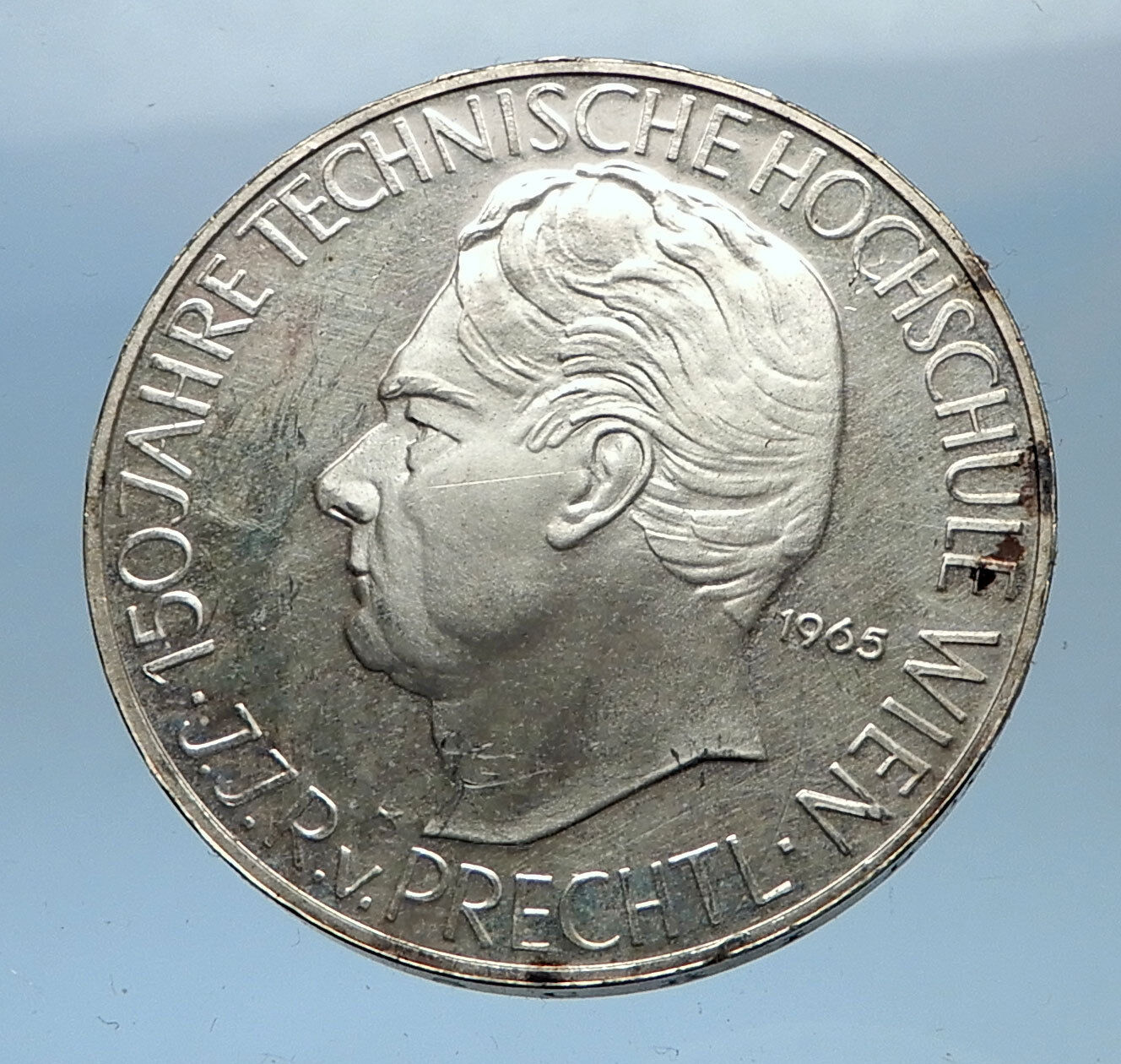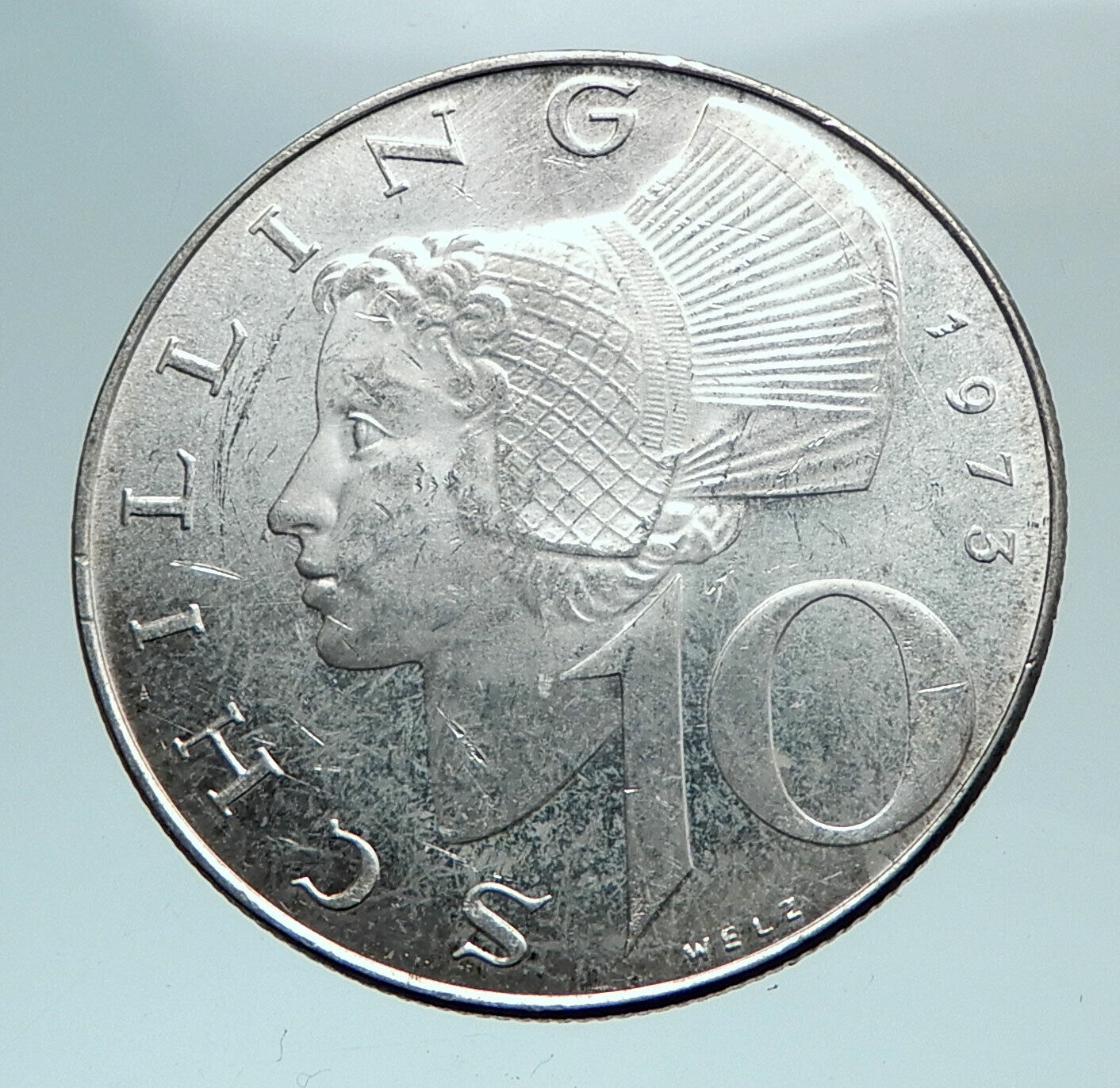|
Austria – 350th Anniversary of the Salzburg University
1972
Proof 50 Schilling Silver 34mm (20.02 grams) 0.900 Silver (0.5787 oz. ASW)
Reference: KM# 2913
(Mintage: 136,000)
350 JAHRE UNIVERSITÄT SALZBURG THEOL. MEDIC JUS PHIL. PA SF MDCXXII MCMLXII BODLAK ·1622-1972·, Great seal of Salzburg University within circle.
· REPUBLIK · 50 SCHILLING ÖSTERREICH, Shields surround value.
Edge Lettering:
FUENFZIG SCHILLING
You are bidding on the exact item pictured, provided with a Certificate of Authenticity and Lifetime Guarantee of Authenticity.
 The University of Salzburg, also known as the Paris Lodron University of Salzburg (German: Paris-Lodron-Universität Salzburg, PLUS), named after its founder, Prince-Archbishop Paris Lodron, is a public university in Salzburg municipality, Salzburg state, Austria. It is divided into four faculties: The University of Salzburg, also known as the Paris Lodron University of Salzburg (German: Paris-Lodron-Universität Salzburg, PLUS), named after its founder, Prince-Archbishop Paris Lodron, is a public university in Salzburg municipality, Salzburg state, Austria. It is divided into four faculties:
- Catholic Theology
- Law
- Cultural and Social Sciences
- Natural Sciences
Established in 1622, the university was closed in 1810 and re-established in 1962. Today, it has around 18,000 students and 2,800 employees and is the largest educational institution in Salzburg state.
Benedictine University
On 23 July 1622 Archbishop Paris Lodron appointed the scholar Albert Keuslin first rector of the Benedictine university. Keuslin, a graduate of the Jesuit University of Dillingen, had established the Akademisches Gymnasium, a secondary school, at Salzburg five years earlier. By resolution of Emperor Ferdinand II, issued on October 8, the Gymnasium was raised to a university. While the Thirty Years’ War raged outside the Archbishopric of Salzburg, the university was built up and maintained by a federation of Benedictine abbeys from Salzburg, Switzerland, Bavaria and Austria. In its early years, courses taught were theology, divinity, philosophy, law, and medicine.
During the Napoleonic Wars, the Prince-Archbishopric was secularized as the Electorate of Salzburg in 1803. It was ruled by Archduke Ferdinand III of Austria, a brother of Emperor Francis I, who established a Faculty of Medicine. After Salzburg was annexed by the Kingdom of Bavaria in 1810, however, the university was closed on 24 December and replaced by a Lyzeum college with sections for divinity and philosophy, as well as a school for medicine and surgery. After the Napoleonic Wars, Salzburg became part of the Austrian Empire.
The divinity section was again converted to a faculty in 1850. In World War I, plans were evolved to relocate the Francis Joseph University from Czernowitz to Salzburg, though never carried out.
University of Salzburg
The University of Salzburg was not re-established until 1962, with a faculty of Catholic theology and a faculty of philosophy. Classes resumed in 1964, with a faculty of law added the following year. In 1975, a new federal law regulated the organisation of all Austrian universities. The University of Salzburg created four academic divisions: the Faculty of Catholic Theology, the Faculty of Law, the Faculty of Humanities, and the Faculty of Natural Sciences. A fifth division, the Faculty of Medicine, was not realized.
In 1995, the organisation of Austrian universities was further restructured with more faculty autonomy. The university gradually incorporated new academic programs through 2004 into 32 Fachbereiche or “departments”, and again, decided not to create a Faculty of Medicine.
![Location of Austria (dark green)– in Europe (green & dark grey)– in the European Union (green) – [Legend]](https://upload.wikimedia.org/wikipedia/commons/thumb/9/9d/EU-Austria.svg/250px-EU-Austria.svg.png)  Austria, officially the Republic of Austria (German: Republik Österreich), is a federal republic and a landlocked country of over 8.5 million people in Central Europe. It is bordered by the Czech Republic and Germany to the north, Hungary and Slovakia to the east, Slovenia and Italy to the south, and Switzerland and Liechtenstein to the west. The territory of Austria covers 83,879 square kilometres (32,386 sq mi). Austria’s terrain is highly mountainous, lying within the Alps; only 32% of the country is below 500 metres (1,640 ft), and its highest point is 3,798 metres (12,461 ft). The majority of the population speak local Bavarian dialects of German as their native language, and Austrian German in its standard form is the country’s official language. Other local official languages are Hungarian, Burgenland Croatian, and Slovene. Austria, officially the Republic of Austria (German: Republik Österreich), is a federal republic and a landlocked country of over 8.5 million people in Central Europe. It is bordered by the Czech Republic and Germany to the north, Hungary and Slovakia to the east, Slovenia and Italy to the south, and Switzerland and Liechtenstein to the west. The territory of Austria covers 83,879 square kilometres (32,386 sq mi). Austria’s terrain is highly mountainous, lying within the Alps; only 32% of the country is below 500 metres (1,640 ft), and its highest point is 3,798 metres (12,461 ft). The majority of the population speak local Bavarian dialects of German as their native language, and Austrian German in its standard form is the country’s official language. Other local official languages are Hungarian, Burgenland Croatian, and Slovene.
The origins of modern-day Austria date back to the time of the Habsburg dynasty when the vast majority of the country was a part of the Holy Roman Empire. From the time of the Reformation, many Northern German princes, resenting the authority of the Emperor, used Protestantism as a flag of rebellion. The Thirty Years War, the influence of the Kingdom of Sweden and Kingdom of France, the rise of the Kingdom of Prussia, and the Napoleonic invasions all weakened the power of the Emperor in the North of Germany, but in the South, and in non-German areas of the Empire, the Emperor and Catholicism maintained control. During the 17th and 18th centuries, Austria was able to retain its position as one of the great powers of Europe and, in response to the coronation of Napoleon as the Emperor of the French, the Austrian Empire was officially proclaimed in 1804. Following Napoleon’s defeat, Prussia emerged as Austria’s chief competitor for rule of a larger Germany. Austria’s defeat by Prussia at the Battle of Königgrätz, during the Austro-Prussian War of 1866 cleared the way for Prussia to assert control over the rest of Germany. In 1867, the empire was reformed into Austria-Hungary. After the defeat of France in the 1870 Franco-Prussian War, Austria was left out of the formation of a new German Empire, although in the following decades its politics, and its foreign policy, increasingly converged with those of the Prussian-led Empire. During the 1914 July Crisis that followed the assassination of Archduke Franz Ferdinand of Austria, Germany guided Austria in issuing the ultimatum to Serbia that led to the declaration of World War I.
After the collapse of the Habsburg (Austro-Hungarian) Empire in 1918 at the end of World War I, Austria adopted and used the name the Republic of German-Austria (Deutschösterreich, later Österreich) in an attempt for union with Germany, but was forbidden due to the Treaty of Saint-Germain-en-Laye (1919). The First Austrian Republic was established in 1919. In the 1938 Anschluss, Austria was occupied and annexed by Nazi Germany.[14] This lasted until the end of World War II in 1945, after which Germany was occupied by the Allies and Austria’s former democratic constitution was restored. In 1955, the Austrian State Treaty re-established Austria as a sovereign state, ending the occupation. In the same year, the Austrian Parliament created the Declaration of Neutrality which declared that the Second Austrian Republic would become permanently neutral.
Today, Austria is a parliamentary representative democracy comprising nine federal states. The capital and largest city, with a population exceeding 1.7 million, is Vienna. Austria is one of the richest countries in the world, with a nominal per capita GDP of $52,216 (2014 est.). The country has developed a high standard of living and in 2014 was ranked 21st in the world for its Human Development Index. Austria has been a member of the United Nations since 1955, joined the European Union in 1995, and is a founder of the OECD. Austria also signed the Schengen Agreement in 1995, and adopted the euro in 1999.
|





 The University of Salzburg, also known as the Paris Lodron University of Salzburg (German: Paris-Lodron-Universität Salzburg, PLUS), named after its founder, Prince-Archbishop Paris Lodron, is a public university in Salzburg municipality, Salzburg state, Austria. It is divided into four faculties:
The University of Salzburg, also known as the Paris Lodron University of Salzburg (German: Paris-Lodron-Universität Salzburg, PLUS), named after its founder, Prince-Archbishop Paris Lodron, is a public university in Salzburg municipality, Salzburg state, Austria. It is divided into four faculties: ![Location of Austria (dark green)– in Europe (green & dark grey)– in the European Union (green) – [Legend]](https://upload.wikimedia.org/wikipedia/commons/thumb/9/9d/EU-Austria.svg/250px-EU-Austria.svg.png)
 Austria, officially the Republic of Austria (German:
Austria, officially the Republic of Austria (German: 





